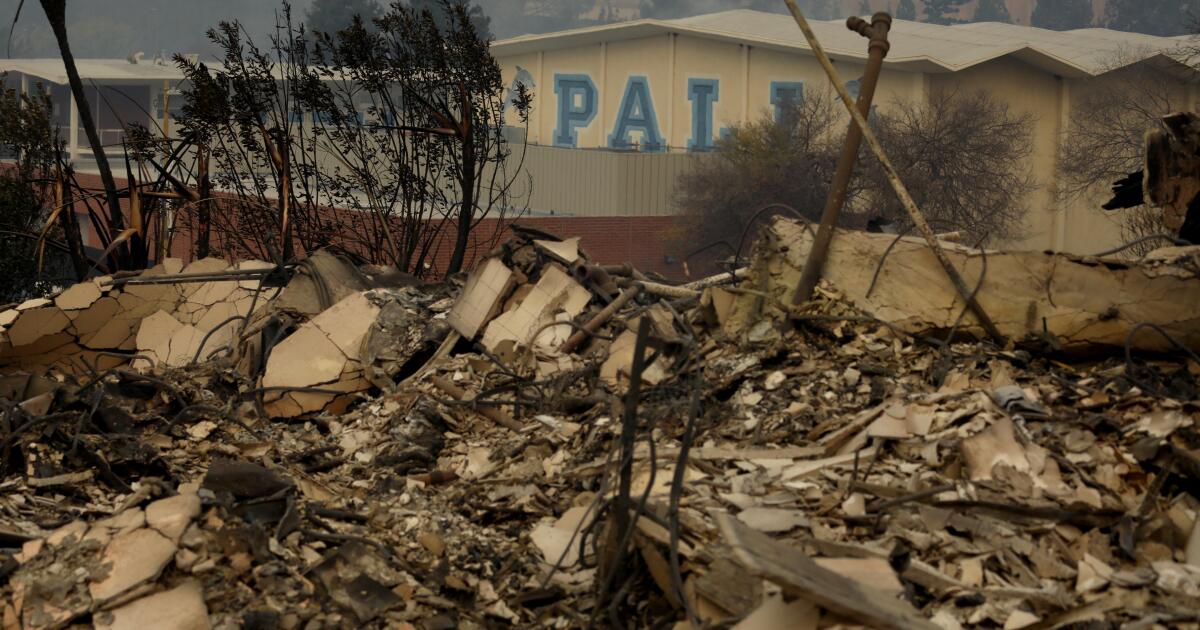Business
Pro-Palestinian activists protest at Google developer conference amid Israel-Hamas war

Dozens of protesters blocked the entrance of Google’s developer conference in Mountain View, Calif., for roughly 90 minutes on Tuesday, demanding that the tech giant drop its work with the Israeli government amid the country’s war with Hamas in the Gaza Strip.
The protest group, which accuses Israel of committing genocide against Palestinians in Gaza, held two events on Tuesday that it said involved hundreds of participants.
A group chanted “Shame on Google” and “Google Cloud rains blood” in the front of the entrance to the conference at Shoreline Amphitheatre, where the tech giant was expected to announce updates to business including its Android and Gemini AI systems. Separately, the protesters held a rally at a nearby park.
The protesters, who call themselves No Tech for Genocide, have been demanding that Google end its cloud computing contract with the Israeli government, known as Project Nimbus.
The latest Israel-Hamas war began when Hamas militants attacked southern Israel on Oct. 7, killing about 1,200 people and taking an additional 250 hostage, according to the Israeli government. Palestinian militants still hold about 100 captives, and Israel’s military has killed more than 35,000 people in Gaza, according to Gaza’s Health Ministry, which doesn’t distinguish between civilians and combatants.
Protesters at the Google event said they believe the company’s technology is being used by the Israeli military for surveillance of people in Gaza through facial recognition, leading to the arrest and detention of Palestinians.
Google did not immediately respond to a request for comment.
The company has said that its technology is used to support numerous governments around the world, including Israel’s, and that the Nimbus contract is for work running on its commercial cloud network, with the Israeli government ministries agreeing to comply with Google’s terms of service and acceptable use policy.
“This work is not directed at highly sensitive, classified, or military workloads relevant to weapons or intelligence services,” Google said in an April statement.
One of the protesters at the Tuesday conference was Ariel Koren, a former Google employee who alleges the company retaliated against her in 2021 after she raised concerns about the contract. Google said at the time that it had investigated the case and found no evidence of retaliation.
“We want to make sure that every single person who comes here and who might think that today’s a day about celebrating technological advancements — every single one of those people needs to understand that the reality is much darker than what Google has painted,” Koren said.
Organizers estimated that 50 people participated in the demonstration in front of the conference. The rally at the park drew a bigger crowd.
One of the participants objected to Google holding its conference the day before Palestinians commemorate 76 years since their mass expulsion from what is now Israel. Palestinians refer to their displacement during the 1948 Israeli-Arab war as the Nakba, which is Arabic for catastrophe.
The protest in front of the Google I/O conference began at around 9:30 a.m., with protesters moving toward a bag checkpoint. Conference attendees had been asked to take out their laptops and have their bags searched.
The event’s security closed the entrance as protesters moved to stand in front, leaving a large line of attendees who were later directed to another area to proceed to the conference. A line of protesters held a red sign that proclaimed “Google Stop Fueling Genocide.” The demonstration ended at about 11 a.m.
Google’s developer conference draws thousands of people each year, many of whom are developers eager to learn about the company’s latest technology.
After witnessing the protest, several attendees said they planned to do more research on Project Nimbus.
“I feel that it is worth a shot to listen to others when they have a point of view,” said Andres Haro, a 30-year-old software security engineer from Utah, as he waited in a long redirected line into Google I/O’s entrance.
The protest comes after more than 50 Google employees were fired following sit-ins and protests that took place at Google office locations last month protesting Project Nimbus. Google said it terminated those workers after an investigation determined they were involved in disruptive activity that violated its policies governing employee conduct.
A spokesperson for the group behind the sit-ins, called No Tech for Apartheid, said they were not involved with Tuesday’s protest.
“We’re asking more questions about what role we and our employers are playing in the world,” said Roni Zeiger, a product developer who participated in the rally on Tuesday at Charleston Park, near the Google event. “World events have continued to evolve and … people, including employees, are asking harder questions and wanting to work at places that are consistent with their values.”

Business
As Delta Reports Profits, Airlines Are Optimistic About 2025

This year just got started, but it is already shaping up nicely for U.S. airlines.
After several setbacks, the industry ended 2024 in a fairly strong position because of healthy demand for tickets and the ability of several airlines to control costs and raise fares, experts said. Barring any big problems, airlines — especially the largest ones — should enjoy a great year, analysts said.
“I think it’s going to be pretty blue skies,” said Tom Fitzgerald, an airline industry analyst for the investment bank TD Cowen.
In recent weeks, many major airlines upgraded forecasts for the all-important last three months of the year. And on Friday, Delta Air Lines said it collected more than $15.5 billion in revenue in the fourth quarter of 2024, a record.
“As we move into 2025, we expect strong demand for travel to continue,” Delta’s chief executive, Ed Bastian, said in a statement. That put the airline on track to “deliver the best financial year in Delta’s 100-year history,” he said.
The airline also beat analysts’ profit estimates and said it expected earnings per share, a measure of profitability, to rise more than 10 percent this year.
Delta’s upbeat report offers a preview of what are expected to be similarly rosy updates from other carriers that will report earnings in the next few weeks. That should come as welcome news to an industry that has been stifled by various challenges even as demand for travel has rocketed back after the pandemic.
“For the last five years, it’s felt like every bird in the sky was a black swan,” said Ravi Shanker, an analyst focused on airlines at Morgan Stanley. “But it appears that this industry does have its ducks in a row.”
That is, of course, if everything goes according to plan, which it rarely does. Geopolitics, terrorist attacks, air safety problems and, perhaps most important, an economic downturn could tank demand for travel. Rising costs, particularly for jet fuel, could erode profits. Or the industry could face problems like a supply chain disruption that limits availability of new planes or makes it harder to repair older ones.
Early last year, a panel blew off a Boeing 737 Max during an Alaska Airlines flight, resurfacing concerns about the safety of the manufacturer’s planes, which are used on most flights operated by U.S. airlines, according to Cirium, an aviation data firm.
The incident forced Boeing to slow production and delay deliveries of jets. That disrupted the plans of some airlines that had hoped to carry more passengers. And there was little airlines could do to adjust because the world’s largest jet manufacturer, Airbus, didn’t have the capacity to pick up the slack — both it and Boeing have long order backlogs. In addition, some Airbus planes were afflicted by an engine problem that has forced carriers to pull the jets out of service for inspections.
There was other tumult, too. Spirit Airlines filed for bankruptcy. A brief technology outage wreaked havoc on many airlines, disrupting travel and resulting in thousands of canceled flights in the heart of the busy summer season. And during the summer, smaller airlines flooded popular domestic routes with seats, squeezing profits during what is normally the most lucrative time of year.
But the industry’s financial position started improving when airlines reduced the number of flights and seats. While that was bad for travelers, it lifted fares and profits for airlines.
“You’re in a demand-over-supply imbalance, which gives the industry pricing power,” said Andrew Didora, an analyst at the Bank of America.
At the same time, airlines have been trying to improve their businesses. American Airlines overhauled a sales strategy that had frustrated corporate customers, helping it win back some travelers. Southwest Airlines made changes aimed at lowering costs and increasing profits after a push by the hedge fund Elliott Management. And JetBlue Airways unveiled a strategy with similar aims, after a less contentious battle with the investor Carl C. Icahn.
Those improvements and industry trends, along with the stabilization of fuel, labor and other costs, have created the conditions for what could be a banner 2025. “All of this is the best setup we’ve had in decades,” Mr. Shanker said.
That won’t materialize right away, though. Travel demand tends to be subdued in the winter. But business trips pick up somewhat, driven by events like this week’s Consumer Electronics Show in Las Vegas.
The positive outlook for 2025 is probably strongest for the largest U.S. airlines — Delta, United and American. All three are well positioned to take advantage of buoyant trends, including steadily rebounding business travel and customers who are eager to spend more on better seats and international flights.
But some smaller airlines may do well, too. JetBlue, Alaska Airlines and others have been adding more premium seats, which should help lift profits.
While he is optimistic overall, Mr. Shanker acknowledged that the industry was vulnerable to a host of potential problems.
“I mean, this time last year you were talking about doors falling off planes,” he said. “So who knows what might happen.”
Business
Insurance commissioner issues moratorium on home policy cancellations in fire zones

California Insurance Commissioner Ricardo Lara has issued a moratorium that bars insurers from canceling or non-renewing home policies in the Pacific Palisades and the San Gabriel Valley’s Eaton fire zones.
The moratorium, issued Thursday, protects homeowners living within the perimeter of the fire and in adjoining ZIP codes from losing their policies for one year, starting from when Gov. Gavin Newsom declared a state of emergency on Wednesday.
The moratoriums, provided for under state law, are typically issued after large fires and apply to all policyholders regardless of whether they have suffered a loss.
Lara also urged insurers to pause for six months any pending non-renewals or cancellations that were issued up to 90 days before Jan. 7 that were to take effect after the start of the fires — something he does not have authority to prohibit.
“I call upon all property insurance companies to halt these non-renewals and cancellations and provide essential stability for our communities, allowing consumers to focus on what’s important at the moment — their safety and recovery,” said Lara on Friday during a press conference in downtown Los Angeles.
Insurance companies in California have wide latitude to not renew home policies after they expire, though they must provide at least 75 days’ notice. However, policies in force can be canceled only for reasons such as non-payment and fraud.
Insurers have dropped hundreds of thousands of policyholders across California in recent years citing the increasing risk and severity of wind-driven wildfires attributed to climate change. The insurance department said residents living in fire zones can be subject to sudden non-renewals, prompting the need for the moratoriums.
In addition, Lara asked insurers to extend to policyholders affected by the fires time to pay their premiums that go beyond the existing 60-day grace period that is mandatory under state law.
It’s not clear how many homeowners in Pacific Palisades and elsewhere might not have had coverage, but many homeowners reported that insurers had not renewed their policies before the disaster struck. State Farm last year told the Department of Insurance it would not renew 1,626 policies in Pacific Palisades when they expired, starting last July.
Residents can visit the Department of Insurance website at insurance.ca.gov to see if their ZIP codes are included in the moratorium. They can also contact the department at (800) 927-4357 or via chat or email if they think their insurer is in violation of the law.
The Pacific Palisades fire, the most destructive fire in Los Angeles history, as of Friday morning had grown to more than 20,000 acres, burning more than 5,000 homes, businesses and other buildings. It was 6% contained.
The Eaton fire, which has burned many structures in Altadena and Pasadena, has spread to nearly 14,000 acres and was 3% contained as of early Friday. Ten people have died in the fires.
Business
In Los Angeles, Hotels Become a Refuge for Fire Evacuees

The lobby of Shutters on the Beach, the luxury oceanfront hotel in Santa Monica that is usually abuzz with tourists and entertainment professionals, had by Thursday transformed into a refuge for Los Angeles residents displaced by the raging wildfires that have ripped through thousands of acres and leveled entire neighborhoods to ash.
In the middle of one table sat something that has probably never been in the lobby of Shutters before: a portable plastic goldfish tank. “It’s my daughter’s,” said Kevin Fossee, 48. Mr. Fossee and his wife, Olivia Barth, 45, had evacuated to the hotel on Tuesday evening shortly after the fire in the Los Angeles Pacific Palisades area flared up near their home in Malibu.
Suddenly, an evacuation alert came in. Every phone in the lobby wailed at once, scaring young children who began to cry inconsolably. People put away their phones a second later when they realized it was a false alarm.
Similar scenes have been unfolding across other Los Angeles hotels as the fires spread and the number of people under evacuation orders soars above 100,000. IHG, which includes the Intercontinental, Regent and Holiday Inn chains, said 19 of its hotels across the Los Angeles and Pasadena areas were accommodating evacuees.
The Palisades fire, which has been raging since Tuesday and has become the most destructive in the history of Los Angeles, struck neighborhoods filled with mansions owned by the wealthy, as well as the homes of middle-class families who have owned them for generations. Now they all need places to stay.
Many evacuees turned to a Palisades WhatsApp group that in just a few days has grown from a few hundred to over 1,000 members. Photos, news, tips on where to evacuate, hotel discount codes and pet policies were being posted with increasing rapidity as the fires spread.
At the midcentury modern Beverly Hilton hotel, which looms over the lawns and gardens of Beverly Hills, seven miles and a world away from the ash-strewed Pacific Palisades, parking ran out on Wednesday as evacuees piled in. Guests had to park in another lot a mile south and take a shuttle back.
In the lobby of the hotel, which regularly hosts glamorous events like the recent Golden Globe Awards, guests in workout clothes wrestled with children, pets and hastily packed roll-aboards.
Many of the guests were already familiar with each other from their neighborhoods, and there was a resigned intimacy as they traded stories. “You can tell right away if someone is a fire evacuee by whether they are wearing sweats or have a dog with them,” said Sasha Young, 34, a photographer. “Everyone I’ve spoken with says the same thing: We didn’t take enough.”
The Hotel June, a boutique hotel with a 1950s hipster vibe a mile north of Los Angeles International Airport, was offering evacuees rooms for $125 per night.
“We were heading home to the Palisades from the airport when we found out about the evacuations,” said Julia Morandi, 73, a retired science educator who lives in the Palisades Highlands neighborhood. “When we checked in, they could see we were stressed, so the manager gave us drinks tickets and told us, ‘We take care of our neighbors.’”
Hotels are also assisting tourists caught up in the chaos, helping them make arrangements to fly home (as of Friday, the airport was operating normally) and waiving cancellation fees. A spokeswoman for Shutters said its guests included domestic and international tourists, but on Thursday, few could be spotted among the displaced Angelenos. The heated outdoor pool that overlooks the ocean and is usually surrounded by sunbathers was completely deserted because of the dangerous air quality.
“I think I’m one of the only tourists here,” said Pavel Francouz, 34, a hockey scout who came to Los Angeles from the Czech Republic for a meeting on Tuesday before the fires ignited.
“It’s weird to be a tourist,” he said, describing the eerily empty beaches and the hotel lobby packed with crying children, families, dogs and suitcases. “I can’t imagine what it would feel like to be these people,” he said, adding, “I’m ready to go home.”
Follow New York Times Travel on Instagram and sign up for our weekly Travel Dispatch newsletter to get expert tips on traveling smarter and inspiration for your next vacation. Dreaming up a future getaway or just armchair traveling? Check out our 52 Places to Go in 2025.
-

 Sports1 week ago
Sports1 week agoThe top out-of-contract players available as free transfers: Kimmich, De Bruyne, Van Dijk…
-

 Politics1 week ago
Politics1 week agoNew Orleans attacker had 'remote detonator' for explosives in French Quarter, Biden says
-

 Politics1 week ago
Politics1 week agoCarter's judicial picks reshaped the federal bench across the country
-

 Politics7 days ago
Politics7 days agoWho Are the Recipients of the Presidential Medal of Freedom?
-

 Health6 days ago
Health6 days agoOzempic ‘microdosing’ is the new weight-loss trend: Should you try it?
-

 World1 week ago
World1 week agoSouth Korea extends Boeing 737-800 inspections as Jeju Air wreckage lifted
-

 News1 week ago
News1 week ago21 states are getting minimum wage bumps in 2025
-
/cdn.vox-cdn.com/uploads/chorus_asset/file/25822586/STK169_ZUCKERBERG_MAGA_STKS491_CVIRGINIA_A.jpg)
/cdn.vox-cdn.com/uploads/chorus_asset/file/25822586/STK169_ZUCKERBERG_MAGA_STKS491_CVIRGINIA_A.jpg) Technology2 days ago
Technology2 days agoMeta is highlighting a splintering global approach to online speech















